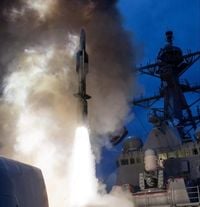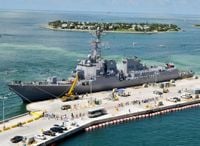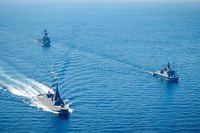MANILA, Philippines — The Philippine Navy is set to expand its naval force units overseeing the West Philippine Sea (WPS) and the waters near Taiwan, a strategic move aimed at bolstering national defense amidst China's increasing assertiveness in the region. Recently, the Department of National Defense approved a reorganization of the Naval Forces West to Western Naval Command and the Naval Forces Northern Luzon to Northern Luzon Naval Command, according to Rear Adm. Roy Vincent Trinidad, the Philippine Navy spokesperson for the West Philippine Sea.
The Naval Forces West, based in Puerto Princesa City, Palawan, is responsible for maritime security in the area, including the Philippine claims in the Kalayaan Island Group within the WPS. Meanwhile, the Naval Forces Northern Luzon, located in San Fernando, La Union, oversees maritime security operations in Panatag (Scarborough) Shoal, the Balintang Channel, and the Philippine Rise, all critical areas facing China's aggressive maritime activities.
Trinidad emphasized the necessity of this expansion, stating, "With the advent of the comprehensive archipelagic defense concept and shift to external defense, they are playing an increasing role in the defense and security of the country." This shift in military focus, introduced in early 2024, aims to transition from counter-insurgency operations to a more robust territorial defense strategy.
The planned changes include transforming these units into divisions and upgrading their highest rank from commodore to rear admiral, a significant elevation in command structure. More personnel and assets will be deployed to these expanded units, enhancing the Navy's operational capabilities. Trinidad noted, "We are looking at a more robust organization for the fleet."
In a related development, the Philippine Navy participated in a multilateral maritime cooperative activity (MMCA) on March 28, 2025, alongside the USS Shoup (DDG-86) from the U.S. Navy and the JS Noshiro (FFM-3) from Japan. This exercise aimed to enhance interoperability and strengthen the combined capabilities of the Philippines, Japan, and the United States in the WPS.
Japan's involvement in this exercise marks a significant milestone in defense cooperation between Tokyo and Manila, as it prepares for its first full-fledged participation in Balikatan 2025. The Japan Maritime Self-Defense Force will join U.S. and Philippine vessels in a joint patrol in the South China Sea, highlighting the deepening military ties amidst rising tensions.
According to preliminary exercise documents, the three nations will conduct a Multilateral Maritime Exercise off the Philippine island of Luzon and beyond the 12 nautical mile territorial limit. This collaboration is a continuation of Japan's increasing role in regional security, having previously conducted its first joint patrol with Philippine forces in April 2024, just before Balikatan 2024.
During the March 28 exercise, the Mogami-class frigate JS Noshiro (FFM 3) joined the USS Shoup (DDG 85) and BRP Jose Rizal (FF 150) near Scarborough Shoal, an area closely monitored by Chinese naval forces. Reports indicate that a Chinese frigate was present during these activities, underscoring the geopolitical tensions in the region.
Balikatan 2025 is anticipated to involve 15,000 to 16,000 troops from the Philippines, Australia, the U.S., and Japan, marking the 40th iteration of this annual military exercise. Major activities will occur across the Philippine archipelago, particularly on the islands of Luzon and Palawan, extending into the South China Sea and the Luzon Strait.
As both nations finalize a reciprocal access agreement, which would allow troop deployments for more intensive training, the timing of the agreement's ratification remains uncertain. However, the joint patrols are expected to proceed regardless of the agreement's status, similar to the previous year's exercise when France participated without a visiting forces agreement.
In recent years, bilateral defense cooperation between the Philippines and Japan has significantly strengthened in response to escalating tensions in the South China Sea. Japan has provided substantial assistance, including funding for a fleet of 17 coast guard patrol vessels, which are actively deployed during incidents involving Philippine and Chinese forces in disputed waters.
In the 2023 and 2024 tranches, Tokyo committed $14 million towards enhancing the Philippines' maritime domain awareness through radars, rigid-hulled inflated boats, and air defense sensor upgrades. This investment reflects Japan's commitment to supporting the Philippines in navigating the complexities of regional security.
As the Philippine Navy gears up for these significant changes, the focus remains clear: to ensure the country's maritime interests are protected amid the ongoing challenges posed by China's assertive actions in the region. With the expansion of naval forces and increased international cooperation, the Philippines is taking proactive steps toward securing its territorial integrity.




